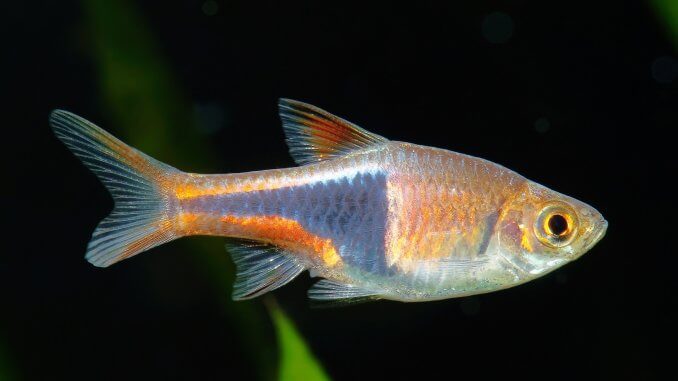
The harlequin rasbora is a freshwater fish of the Cyprinidae family native to Singapore, Malaysia, Sumatra, and southern Thailand. The orange- or pink-colored harlequin rasbora is very similar to the lambchop rasbora and glowlight rasbora.
The harlequin rasbora is popular with aquarists because of its schooling behavior and vibrant colors. Harlequin rasboras are a great choice for a smaller community tank and are suitable for beginner aquarists.
TABLE OF CONTENTS
Harlequin Rasbora Facts & Overview
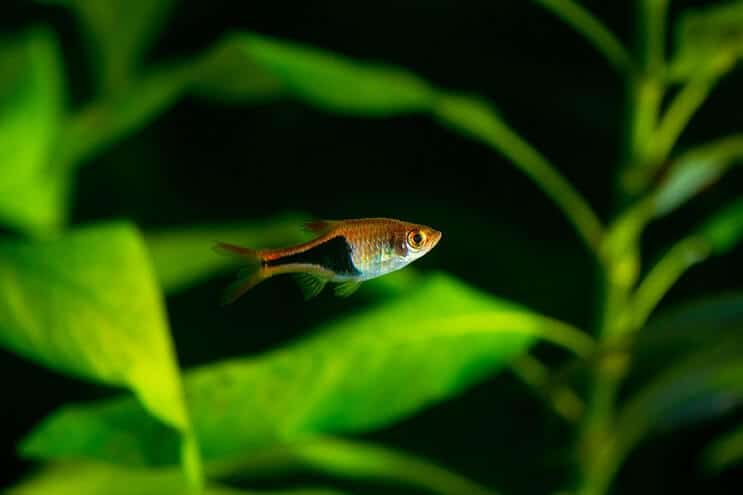
| Scientific name: | Trigonostigma heteromorpha |
| Common names | Red rasbora, harlequin fish, harlequin rasbora, harlequin |
| Distribution: | Singapore, Malaysia, Sumatra, and southern Thailand |
| Size: | 1.75–2 inches |
| Life expectancy: | 5–8 years |
| Color: | Orange-pink body with a black wedge-shaped marking |
| Diet: | Omnivore |
| Temperament: | Peaceful |
| Minimum tank size: | 10 gallons |
| Temperature: | 72–81°F (22–27°C) |
| pH: | 6.0–7.8 |
| Hardness: | 2–15 dGH |
| Care level: | Easy |
| Breeding: | Egg-layer |
Origin
The harlequin rasbora (Trigonostigma heteromorpha) is a tropical freshwater fish found in Southeast Asia, throughout western Malaysia, southern Thailand, and Singapore. In nature, harlequin rasboras inhabit forest streams and heavily vegetated peat swamps with slow water flow.
These waters are characterized by the low mineral content and high concentrations of dissolved humic acid. The presence of organic debris gives the water a yellowish-brown hue.
The International Union for Conservation of Nature and Natural Resources (IUCN) lists the harlequin rasbora on the Least Concern list, meaning the species is still plentiful in the wild.
Adult Size & Lifespan
Harlequin rasboras are small fish, growing 1.75 to 2 inches long. These fish vary in size and appearance, depending on the region of origin. Harlequin rasboras from Thailand are often smaller and slimmer than those from Singapore. Female harlequin rasboras are slightly larger and thicker than males.
The average life expectancy of harlequin rasboras is between 5 and 8 years.
Availability
Harlequin rasboras are among the most popular schooling fish and are available in most pet stores.
Currently, these online stores have stock of harlequin rasboras:
A single harlequin rasbora costs $3.50–$4.50 on average, while a school of six costs $19–$26.
Appearance
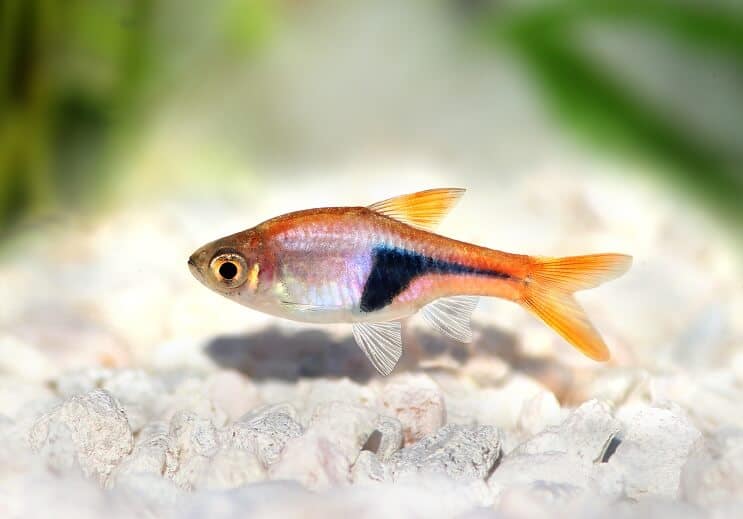
The harlequin rasbora’s vibrant appearance and peaceful behavior make this species extremely popular among aquarists. These small fish are fairly hardy and adapt to most aquarium conditions.
Colors, Patterns, Fins, and Sex Differences
The harlequin rasbora is a small fish with an elongated and laterally compressed body, a small terminal mouth, and a deeply forked caudal fin. These rasboras are very similar to their cousins, the lambchop rasbora and glowlight rasbora, but are much stockier with a convex belly area.
Like all other cyprinids, the harlequin rasbora’s pectoral fins are behind the gill cover. The pelvic fins are located further back, along the ventral portion of the body.
The dorsal, pelvic, anal, and caudal fins of the fish are tinted red. The inner section of the forked caudal is crystal clear, with the red color concentrated in the outer areas of the tail.
The bodies of these fish can vary in color from a pale pink or bright red to copper orange. The harlequin rasbora’s body is adorned by a black triangular marking that covers the back half of the fish’s side, parallel to the gills. The distinctive wedge-shaped marking stretches from the dorsal fin and comes to a point near the base of the caudal fin.
Both male and female harlequin rasboras have a black wedge-shaped marking on the back half of their bodies. This patch is larger in male fish and has a rounded extension at the bottom edge. On females, the black wedge is completely straight.
There are several color morphs of the harlequin rasbora. Fish with copper or golden-colored bodies are called golden harlequin rasboras. Black harlequin rasboras have mostly black bodies and a black triangular patch. Fish with a strong bluish hue are referred to as blue harlequin rasboras.
Typical Behavior
The active and fast-moving harlequin rasboras are peaceful community fish. These schooling fish do best in groups of 10 or more individuals. Harlequin rasboras get along with most fish. But some less active fish species may not tolerate the rasbora’s active lifestyle.
In the aquarium, these fish spend most of their time in mid-levels, rarely venturing to the bottom or the surface. Harlequin rasboras will hide among plants or caves when stressed or trying to get away from bright light or bigger tankmates.
Harlequin Rasbora Care & Tank Requirements
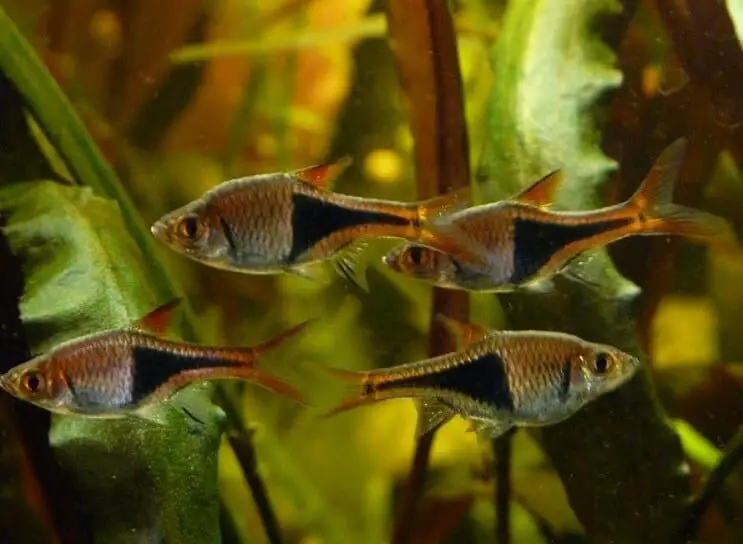
Harlequin rasboras are easy to care for. These hardy schooling fish are a great choice for beginner aquarists.
The natural habitat of this species consists of soft, slightly acidic water and slow water movements. These fish prefer environments with dense vegetation, an open area for swimming, dark substrate, and low-light conditions.
Set up the harlequin rasbora’s tank with the fish’s natural habitat in mind. A spacious, heavily planted tank with a good filter that won’t create strong water movements, and a dark substrate will help harlequin rasboras feel at home.
These fish are omnivores. In the wild, the species feeds on worms, small insects, zooplankton, and crustaceans. Feed harlequin rasboras a balance of high-quality flake or pellet food and offer live brine shrimp or bloodworms as treats.
Habitat and Tank Requirements
Harlequin rasboras are hardy schooling fish. Caring for these fish is easy, as long as you keep their tank and water clean.
The natural environment of the fish is unique. The warm blackwaters are very dark and have high concentrations of humic acid. Despite the dark appearance, the water is clean and has a slightly acidic pH balance.
These fish spend the most time in the open water of the middle and upper levels of the tank. The species needs room to swim around and does best in long aquariums of 36 or more inches.
To mimic the harlequin rasbora’s natural environment, use a good filter that won’t create strong water movements. These fish prefer to live in very sluggish waters, so a powerful filtration system isn’t necessary.
Carry out monthly water changes of at least 25%–50% to maintain water quality. In densely stocked aquariums, replace 20%–25% of water weekly or every other week. During the water changes, vacuum the substrate to prevent the accumulation of waste.
Cover the bottom of the tank with soft sand or gravel, or use a dark substrate to bring out the harlequin rasbora’s colors. Aquascape the tank using dense plantings, bogwood, dry leaves, rocks, and broad-leaved plants. Use floating plants to diffuse the light entering the tank. The plants create shadows that will increase the harlequin rasbora’s security.
Tank Conditions
A minimum tank size for harlequin rasboras is 10 gallons, though a 20-gallon tank is preferred. These fish are schooling fish that must be kept in a group of 8 to 10 individuals. Schools of larger numbers require larger tanks and make a beautiful display.
Fill the tank with soft freshwater to mimic the harlequin rasbora’s natural habitat. These tropical fish are used to living in warm water, so keep the water’s temperature in the 72–81°F range.
The species is found in slightly acidic waters, so the pH level inside the tank should be in the 6.0–7.8 range — ideally 6.5. The aquarium should be filled with fresh water at a 2–15 dGH water hardness level, and no brackish water should be present. Harlequin rasboras adapt to most aquarium conditions, but their colors show best in soft, slightly acidic water conditions.
A good filtration system is necessary to keep the tank clean and maintain water quality. Filtration should create moderate currents that won’t disturb the water area where harlequin rasboras swim.
| Water type: | Soft, freshwater |
| Tank size: | 10-gallon minimum, 20 or 30-gallon preferred |
| Water temperature: | 72–81°F (22–27°C) |
| Substrate: | Sand, rocks |
| Tank setup: | Live plants, bogwood, any type of rock |
| Acidity: | 6.0–7.8 pH |
| Water hardness: | 2–15 dGH |
| Filter: | Yes, a filtration system keeps the tank clean and maintains water quality |
| Plants: | Yes, an air pump creates surface movements that add oxygen to the water and can help keep the water oxygenated during the summer months |
Harlequin rasboras need a spacious, heavily planted tank with room to swim freely. Install a good-quality filter and perform regular water changes to maintain water quality and keep the tank clean.
Disease
Harlequin rasboras are resilient to disease. But like other freshwater fish, harlequin rasboras can be affected by common fish diseases. Stress, lack of a nutritious diet, and poor water quality increase the risk of fish getting sick.
Harlequin rasboras may get affected by the following diseases:
- Dropsy, also known as edema or ascites, refers to the swelling of soft tissues and the buildup of water in a fish’s body. A bacterial infection causes this condition in fish with already compromised immune systems. Dropsy is a highly contagious and fatal condition if not diagnosed in time. Treatment often includes quarantining any sick fish and administering antibiotics
- Ich is a highly infectious parasitic disease that affects many freshwater fish species. The parasite penetrates a fish’s skin or gills, causing small white spots on the body. There are several treatment options for ich, including medications, herbal remedies, or raising the water’s temperature to 86°F for three days
- Fin rot is one of the most common diseases in aquarium fish. Fin and tail rot results from a bacterial infection and causes black, white, or brown spots on the fins, tail, or body. Treatment involves using antibiotics that are effective against gram-negative organisms
Tank Mates
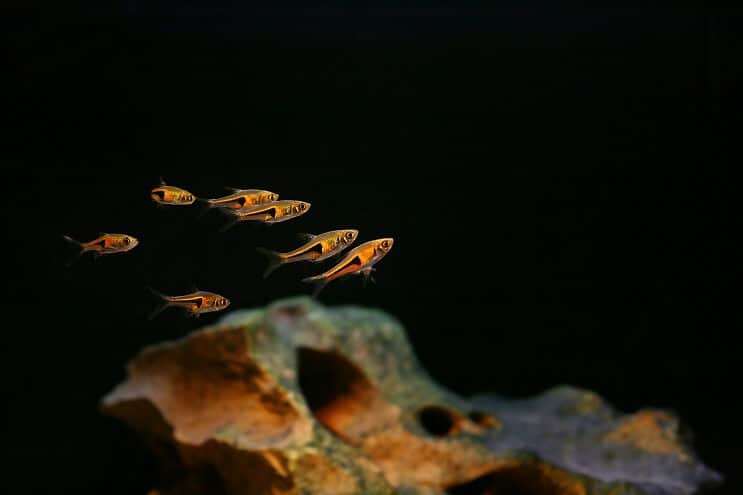
Harlequin rasboras are small, non-aggressive community fish that must live in a group of 8 to 10 individuals.
These peaceful fish get along with any fish, as long as it isn’t large and predatory. The fast-moving lifestyle of harlequin rasboras may be too much for some less-active tankmates.
Great tankmates for harlequin rasboras include:
- Neon tetra
- Rummy nose tetra
- Danios
- Dwarf gourami
- Cherry barbs
- Cory catfish
- Apistogramma
- Honey gourami
- Bolivian ram
- Mollies
- Kuhli loach
- Guppies
- Hatchetfish
- Platies
Non-fish aquarium species that can be housed with harlequin rasboras are snails and shrimp.
Diet and Feeding
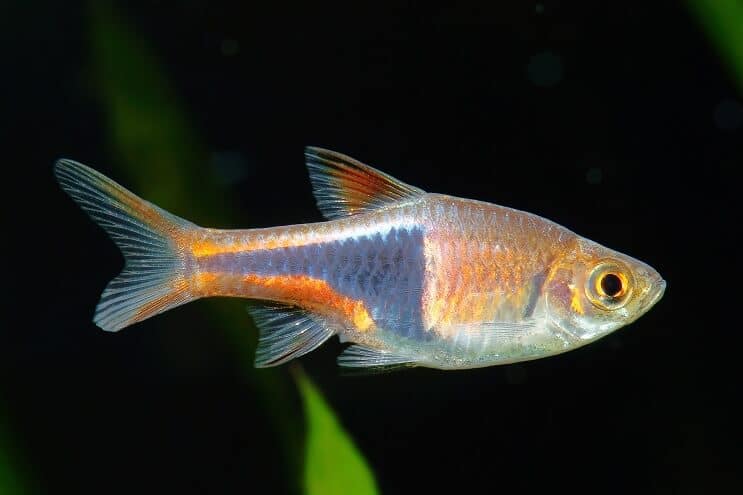
In the wild, the omnivorous harlequin rasbora eats small insects, worms, crustaceans, and zooplankton. In the aquarium, these fish need a balance of high-quality pellet and flake food, supplemented with an occasional live brine shrimp, Daphnia, or bloodworm. Harlequin rasboras thrive on a varied diet that meets their nutritional needs.
These fish do best when offered smaller amounts of food several times a day. Feed harlequin rasboras only what they can eat in three minutes or less at each feeding. When feeding once a day, provide as much food as harlequin rasboras can eat in five minutes.
Breeding
Breeding harlequin rasboras can be challenging. These fish require optimal conditions to begin spawning, and even then, the fish can spawn for days before mating takes place. Unlike other cyprinids, harlequin rasboras are open water egg-layers and attach their eggs to the underside of broad-leaved plants.
To successfully breed harlequin rasboras, select young individuals and condition them with small offerings of live food several times a day for about four weeks. Conditioning with food should encourage mature females to fill out with eggs and will help bring out the male’s color.
How to Prepare
Provide a dimly-lit breeding tank and keep the water level at around 6–8 inches. Simulate the natural water chemistry parameters as closely as possible. The water should be soft, no higher than 1.5–2.5 dGH, with a slightly acidic pH of 5.3–6.0 and a temperature between 77–82.4°F.
Set up the breeding tank with live or artificial broad-leaved plants like Cryptocoryne or Microsorum. Add a spawning mop to the tank so eggs that don’t attach to the plant’s leaves have a place to fall.
The Breeding Process
After preparing the breeding tank, introduce the breeding pair later in the day.
When breeding groups of young harlequin rasboras in a single tank, keep two males for every female.
Harlequin rasboras spawn in the morning. Spawning is initiated by the male, who takes the female under a broad-leaved plant. The male performs a courtship dance, nudging the female’s sides and rubbing her belly with his back.
When the female is ready to spawn, the pair will move under the plant leaves, where 6 to 12 eggs will be deposited at a time. The fertilized eggs will adhere to the underside of the leaves. The female will typically lay 80–100 eggs in one or two hours.
Remove the parents as soon as the spawning is over because harlequin rasboras eat their eggs and fry. Harlequin rasbora eggs need around 18 hours to hatch at a temperature of 80°F and become free-swimming in three to five days.
Feed the free-swimming fry infusoria for the first few days. The fry grows quickly and can start eating baby brine shrimp once it is between 7 and 14 days old.
Should You Get a Harlequin Rasbora for Your Aquarium?
The harlequin rasbora is among the most popular schooling fish that will add color and vibrancy to any community tank. These hardy and adaptable fish get along with most other peaceful species of a similar size.
Easy to care for and enjoyable to look at, harlequin rasboras are an excellent choice for beginner aquarists. Keep a group of at least 8 to 10 harlequin rasboras in a spacious and well-planted tank.

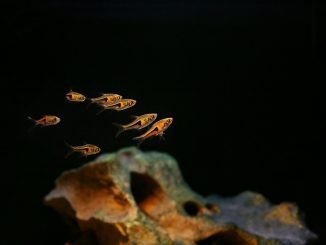
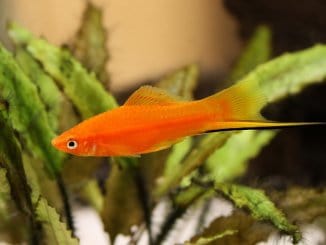
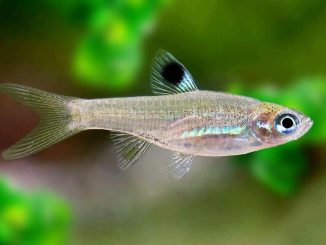
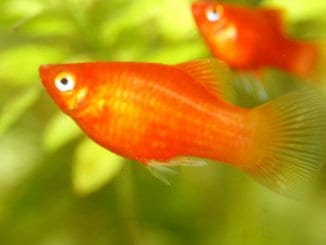
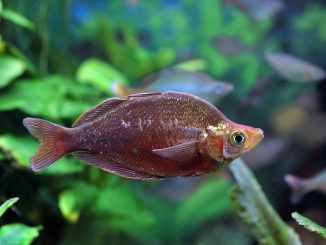
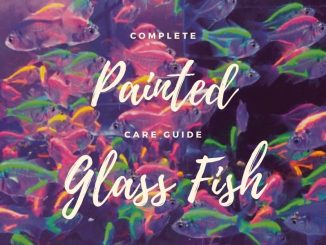
Hi I have a 10 gallon tank and I want to put harlequin rasboras with guppys is my tank to small? New to this
Hi Jas, given that both of those species like to be kept in small groups, a 10 gallon tank is too small. You can keep 3 or 4 Guppies, or 2 – 3 Rasboras in a 10 gallon, depending on which species you’d like. Thanks, Robert
Thanks Robert
Is a plant set up necessary for harlequins or can I keep them with artificial plants in my aquarium?
Hi Piyush, artificial plants are fine too. Thanks, Robert
Hi I was wondering and it is probably a stupid question but I’ll ask it anyways would I be able to put these fish in a five gallon?
Hi Hope, they need a minimum tank size of 10 gallons. Thanks, Robert
Hi I was wondering how many Harlequin Rasboras can you put in a 10 gallon tank? They will be in there with 1 cory catfish.
Hi Beth, 4 will be fine in a 10 gallon tank with your Cory. Thanks, Robert
I have had the hardest time finding breeding information on harlequins. I have had mine for almost two weeks and two days after I got them they began trying to spawn. They do this every two days. I have 2 males and 6 females and the males just chase all the females and will sometimes try to wrap their tail around the females under the broad leaf plant but no eggs have been laid. What gives? Do I need more males to females? Do I need to separate a pair? Thanks
I’m looking at getting a 10 gallon tank soon. I’m planning on using real plants and will have an algae eater (tbd as I’m still researching). I love bettas and was thinking of getting a small shoal of 4-5 of these. Would that be overloading the tank?
I don’t think that would be overloading, but they would quickly outgrow your setup. Also, it is not recommended to keep them with betas or any other aggressive fish. You would have to get a lot of plants to provided hiding places and in a ten-gallon, it probably wouldn’t leave a lot of open swim space. For clean up, algae eaters are great, look into corydoras as well. I personally like albino bristlenose plecos but they have a large bioload.
No, but you should get at least 5 rasboras.
Hello, how many Rasboras could I put with a Honey Gourami in a 10g tank? Thanks
I have a small shoal of harlequin rasboras, they are colorful and charming. But one of them looks damaged. It came this way from the store: it looks like its spine was broken, and when it healed, it left the fish’s back almost V-shaped. It doesn’t have any problem swimming or getting food, but it is weird looking! What might have caused this? Thanks.
Hi Jamie, I had the same issue and have isolated the damaged fish as I’m scared that it’s fish Tb… What did you find out? I’m trying to determine whether this fish is OK or not. Behaviour is pretty normal, but now I’m scared that these fish could have contaminated my community tank..
Hi, can Khuli Loaches and Harlequin Rasboras be housed together? I’ve always wanted to have those fish, and I think they could look cool together. I’ve read that they are quite pleasnt when in groups, so I’m thinking maybe it would be okay? And if they can’t be housed together, could Bristlenose Plecostomus or Powder Blue Gourami be with the rasboras?
Thanks!
Do all juveniles look the same? I bought some Espei, Black, and Golden Harlequin Rasboras and they all look identical. Is this something that is normal?
My Rasboras are on that Betta leaf spawning!
This article recommends 2 Harlequin Rasboras per gallon, I thought the common advice is to have 1 inch of fish per gallon, if Harlequin Rasbora can grow up to 2″ shouldn’t there be 2 gallon per fish instead of 2 fish per gallon?
Can these be kept with a betta fish and 2 african dwarf rogs in a 10 gallon tank?
Could I put 6 of these in a 10 gallon with 2 African Dwarf frogs and a young boy betta?
Our two rasbora fish tremble and hide under the silk plant when we turn the tank light on. Do we need to keep the tank dark?
Love my harlequin rasaboras. Have school of seven in my 20 gal long tank. Lots of plants. Had some cherry barbs with them around seven but after a month or so started to loose them. Mysterious deaths. Took bal out and now the rasaboros are swimming in schools again and seem to be happy by themselves. Three Cory’s for bottom. Might add few more and leave them as my only fish.